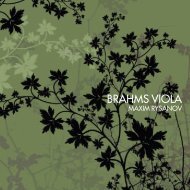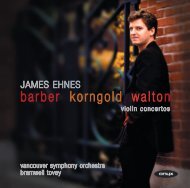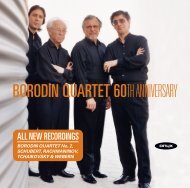BRAHMS Piano Quartets 1 & 3 - Onyx Classics
BRAHMS Piano Quartets 1 & 3 - Onyx Classics
BRAHMS Piano Quartets 1 & 3 - Onyx Classics
Sie wollen auch ein ePaper? Erhöhen Sie die Reichweite Ihrer Titel.
YUMPU macht aus Druck-PDFs automatisch weboptimierte ePaper, die Google liebt.
Brahms: <strong>Piano</strong> <strong>Quartets</strong><br />
In July 1861 Brahms moved to Hamm, a picturesque country suburb on the left bank of the Alster<br />
near Hamburg. There, the idyllic home of Elisabeth Rösing provided him with an inspiring environment<br />
in which to compose. The resultant outpouring began with his first two complete <strong>Piano</strong><br />
<strong>Quartets</strong>, in G minor and A major. The first, op. 25, had already been conceived some years before,<br />
around 1857. But it was at Hamm that it finally came to fruition, combining a wide-ranging musical<br />
language with a symphonic breath of formal vision – as Arnold Schoenberg observed by making a<br />
spectacular orchestral transcription.<br />
On completion the G minor Quartet was, as with so much of Brahms’ output, sent to Clara Schumann<br />
for comment. Clara and another of Brahms’ close friends, the violinist Joseph Joachim, criticised the<br />
opening movement for its brooding character, fluidity of form and preoccupation with the secondary<br />
key area of D major. However, Brahms would, in time, be hailed as innovative for his employment<br />
of these devices.<br />
Brahms’ manuscript for the opening movement includes a repeat sign at the end of the exposition,<br />
but this was scribbled out and replaced by ten bars reiterating the opening material – a false reprise<br />
– before a pause heralds the start of the development. In similar vein, the recapitulation begins<br />
ambiguously in G major rather than the expected tonic, rendering its starting point unclear; Clara<br />
took a dim view of what she saw as uncertainty, but for Brahms such formal flexibility was the best<br />
means of expressing his ideas.<br />
The turbulence of the opening movement is thrown into relief by the C minor Intermezzo that follows.<br />
This is an early instance of the kind of subtle scherzo, less frenetic than those of Beethoven,<br />
which became a hallmark of Brahms’ oeuvre; its understated vocabulary offers a piquant counterpoint<br />
to the unbuttoned emotions of the outer movements. Brahms did initially label the movement<br />
‘Scherzo’, but changed it to ‘Intermezzo’ at Clara’s suggestion. The main theme makes use of Robert<br />
Schumann’s ‘Clara’ theme (C–B–A–G sharp–A, the B standing for l and G sharp for r).<br />
Yet in the Andante con moto it is as though the burden carried by the first two movements has lifted;<br />
a full-throated, lyrical theme in E flat is offset by a jaunty march in C major. This relaxation in<br />
turn presages an infectiously exuberant finale alla Zingarese, an updating of the genre of ‘gypsy’<br />
finale pioneered by Haydn. The virtuosity demanded of the performers, in particular from the















